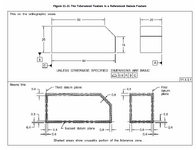edw.jack23
Industrial
- Jun 22, 2022
- 9
Hi all,
I have a part with a general profile tolerance that apply to linear basic dimensions such as in the figure below. The question I'm having trouble with is how much "tolerance" the linear dimensions have. Take the 60mm dimension for example it seems that one side can vary .4 and the other .8 so is there a tolerance of ±.12mm? Or is it entirely surface based and there is not "total". Let me know if I need to clarify. Any help appreciated!

I have a part with a general profile tolerance that apply to linear basic dimensions such as in the figure below. The question I'm having trouble with is how much "tolerance" the linear dimensions have. Take the 60mm dimension for example it seems that one side can vary .4 and the other .8 so is there a tolerance of ±.12mm? Or is it entirely surface based and there is not "total". Let me know if I need to clarify. Any help appreciated!

